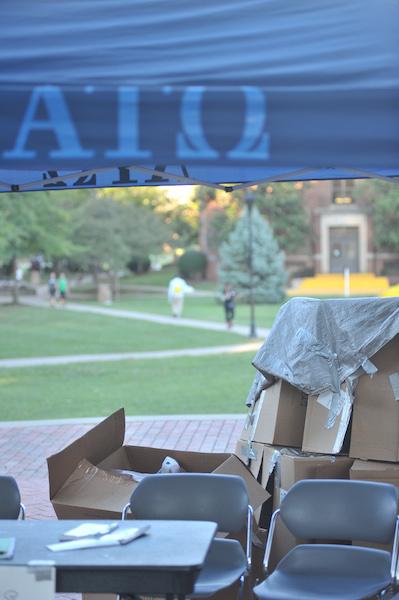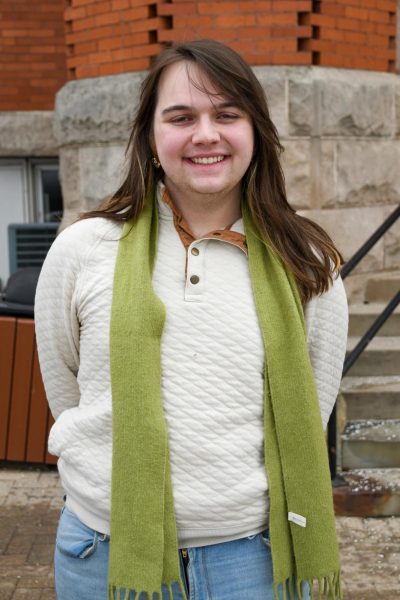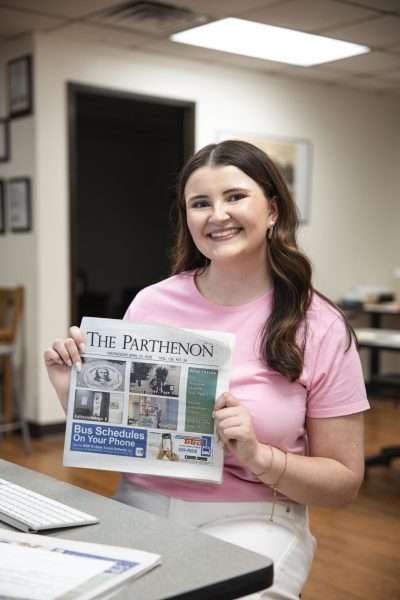EDITORIAL: ATO plays homeless

Members of Alpha Tau Omega absent from their cardboard box shelter Thursday at 6:30 p.m.
Alpha Tau Omega is set up in front of the Memorial Student Center once again in hopes to raise awareness about homelessness and funds for the Huntington City Mission.
Each fall semester, the fraternity builds a shelter out of cardboard boxes and tarps, and members of the fraternity take shifts in the shelter throughout the week. The idea is to emulate homelessness and raise awareness and funds for a worthy cause.
While ATO’s intentions may be pure (last year’s event drew in over $2,000), it’s difficult to ignore how crass the entire event seems, with its basis firmly rooted in the exploitation of homelessness as well as the hardships that go along with it.
Homeless people aren’t homeless in shifts. The homeless can’t escape their predicament at the onset of actual struggle or have home-cooked meals/take-out delivered. They also don’t have the luxury of using cell phones or laptops to pass time with while staying sheltered from the sun under an ATO-labeled tent with box fans.
Homelessness is a pervasive issue, with a 2015 report by the U.S. Department of Housing and Urban Development finding more than 83,000 individuals and 13,000 American families were chronically homeless. The National Alliance to End Homelessness characterizes “chronic homelessness” by long-term, repeated homelessness, sometimes accompanied by a disability. Chronic homelessness becomes a void many men and women across the nation simply can’t escape.
Real homeless individuals must grapple with the constant search for shelter or contend with environmental factors, like weather, should shelter be unreachable. Even when homeless citizens can stay the night in a homeless shelter, they’re often subjected to physical and sexual abuse, among other issues.
The Red Cross is reported to kick homeless people out of their shelters for things like gender identity or sexual preferences, making another group of people who are already stigmatized even more afflicted. The National Coalition for the Homeless report that up to 40 percent of homeless youth identify as LGBT. Those people are almost guaranteed to have a more difficult time as opposed to the experience of heterosexual homeless people.
The Treatment Advocacy Center reports that 28 percent of homeless people are affected with some sort of mental illness. America’s view on the mentally ill is already negative, so this, combined with the general public’s view on the homeless, equates to even more struggles. It’s also worth considering the malleability of homelessness, with some citizens slipping in and out of the socio-economic status on a regular basis. More than 500,000 Americans were homeless at one point, according to the department’s report.
In the face of these facts, what ATO is sorely missing is its scope. They don’t recognize that their event is perpetuating the idolization of struggle by a more privileged class, and they seemingly don’t understand that their event is insensitive to a class of people they likely share no identification with.
It is understandable to have something out in the open for visibility’s sake, but this just isn’t working. The fact that ATO feels haphazardly arranged cardboard boxes and tarps represent what it’s like to be homeless speaks volumes about their experience with the homeless community. What would a homeless person think if they encountered this display? Surely they would not feel like ATO is doing them any favors. Non-mandated community service hours would be a step in the right direction.
In short, ATO’s efforts undermine their fraternity, the university and any legitimate attempts to raise awareness about the reality of homelessness. Maybe next year, the fraternity should consider a more orthodox approach, like a bake sale.
Your donation will help continue the work of independent student journalism at Marshall University. If you benefit from The Parthenon's free content, please consider making a donation.







Mike • Sep 5, 2016 at 8:12 pm
Dear Mr. Fisher & Editor Staff,
I wanted to respond to your editorial “ATO plays homeless”. I also am one of the original member to start this endeavor nearly a decade ago. I found your article to be hateful & sophomoric. Not sure if you have been caught up in the divisive election cycle or you just didn’t like to see guys in backwards hats, flip-flops and khakis not fit your stereotype and preconceived notions. I would like to address your concerns you raised in your article in first the history, goals and critics.
History:
If you faired to look in the archives of the Parthenon papers, you may have noticed that this event was once held during the week prior to Thanksgiving. Members in fact did sleep in cold temperatures. After several years of the event with each time growing in size, our national headquarters suggested, that we switch to the beginning of the semester, to capitalize on when students and the community have had some extra spending money from mom & dad and before people think of presents and gifts for family members during winter break. To our surprise, even with more events and competition our event grew. Eventually the idea has spread to chapters across the nation.
Goals:
The goals of ATO with this project are simple; first to raise as much money for a local charity, since again this is a problem we have seen, and which Huntington gets a bad wrap. Second, to have us and our peers think. As we are privileged, privileged to go on to higher-education, privileged to walk on the beautiful campus that is Huntington-Main, when people half-a-mile away struggle. We hope that we may start to begin awareness, discussion and thought provoking within the campus. Third, promote teamwork, leadership, civics, and philanthropy among our members.
Critics:
First , your article starts off with some small facts about the project then goes straight for the backwards compliment about our good intentions as you firmly stated “rooted in the exploitation of homelessness” . You failed to mention nor respond to the already stated fact that 100% of the donations go to the Huntington Mission.
Your second critic is that we are basically not “hardcore, extreme, or authentic” because many of our members have other responsibilities, clubs, jobs, class, studying to complete. Our members in interviews have stated they feel lucky and privileged to come back to their dorm or house. I would ask Mr. Fisher and the staff to check their own privilege. Did you write this critic in one of our new dorms with all the bells and whistles for our freshman and sophomores? The glorious Drinko library. Or where you typing this up at Starbucks? You “play” as if you can read the souls, intentions, and life-experience of all our members, which in-itself is pretentious. You could have interviewed these members to make your point but again a missed opportunity. Instead of looking at the hut as some street art hoping to get people to think about who those faces may be or imagen if they saw someone they knew.
Third your “Red-Cross” critic is a thinly-vailed shot at Huntington City Mission, because in your mind and others, this is not a well-deserving non-profit in your eyes. Whether it is because its origins as a non-denominational Christian organization, which you equate to discrimination. However, if you wanted to include any interviews with your numerous homeless sources or contacted the City Mission about their policy then we could make a decision as a whole.
Fourth, your complaint about mandatory community service. Yes, we expect our members to contribute to our events. The question you should have asked is how many of these gentlemen exceeded this requirement, which is more of a way to say to our members what the expectations for our groups and our members.
Fifth, your real complaint is that trying to pick on a soft target like a fraternity is easy and even part of pop-culture. We get it and we expect it, you assume to know our lives and try to convince readers that our motives are malice. Instead of focusing on the negative or even given the fraternity a valid critic, you failed to offer any suggestions, while condemning your fellow students for trying to make a small difference. You could have made your point by stating that the first 10 years are great but hope the next 10 years are even better, but you choose not to be apart of the solution, instead of offering sarcastic remarks such as a more orthodox bake sale. Not even my ma-maws’ brownies got three articles, so please let the focus being on donations and the homeless. Your article only furthers to take away from the true purpose, which is We are Marshall, We are Huntington, We are One.
Cody • Sep 8, 2016 at 5:09 pm
^
THIS. I only hope that people spread this comment around in retaliation because this is exactly what everyone needs to see. The perfect response from a founding member of this event. I applaud you, sir.
MM • Sep 8, 2016 at 6:17 pm
I came across this article this morning and my first impression was that I am personally hoping the intention of the writer does have a personal reason of why he would attack a fraternity, and not for the larger picture of this is a group of young men already that have an awareness of a problem add attempting to make a difference. It saddens me to find that the writer is the most insensitive to the homeless Problem, and so critical of people that are making a difference in a world that needs a difference.
I am a middle age adult who has been an advocate for the homeless. I did not start at 18, or as a college student. I first saw this article and was touched, proud, and happy that young adults recognize a problem, and start helping with a solution. I did not see any of them living in a box because I am not in Huntington, WV. I did see the article of their philanthropy project and had donated $100.00. I didn’t need to see them going without to donate and help them raise money for their cause. I have looked in the eyes of the homeless, took them to food banks, prepared meals,gave the shoes off my own feet, and fitted and bought shoes for homeless children. I have only made a small difference,but I have made more of a difference than if I have done nothing. .
I praise this Fraternity for their efforts. They are doing something that I didn’t do in my undergraduate or graduate years. Please don’t take this criticism and stop your efforts- make them even stronger. Your efforts and this article will make me an annual supporter in your collections.
You brought awareness, and even small minded opinions brought more attention to your cause. This fraternity may not be in a box 24/7 but they aren’t living living under a box either and ignoring social problems – they are trying to solve the problems, or at least helping. Wish the fraternity much continued success, and thank you!
Connor • Sep 4, 2016 at 5:52 pm
Having mandatory volunteer and fundraising events is not in itself a negative. These are generally students who, let’s face it, would never volunteer their time and effort for the betterment of their community.
I have said every year that the homeless farce they put on is more of an insult and raises the wrong kind of awareness to a very real problem. There is clearly better ways to help that doesn’t also promote ATO.
Great article, great insight. Keep up the good work.
Daniel Hudson • Sep 4, 2016 at 1:08 am
I’ve been bothered by this for a while. Actual homeless folks I’ve talked to around town hate the mission, and there are a few other services thatneed support, like Harmony House.
I think this is a great article, and the members of ATO should listen and learn to be more creative. I would advise bringing on actual homeless people to talk about their experiences. Invite actual homeless people to inhabit campus for a week. That’s how you raise awareness.
The responses we can read from the Greeks here clearly show that it’s about their self aggrandizement as much as it is raising money for an organization they believe does well. I believe they could do better here.
Caleb Mitchell • Sep 3, 2016 at 10:32 pm
I see you deleting my first post. Let me re-explain my feeings without explicit language since that offends you guy too. As I was saying My buddy Matt Reeeegs pointed out pointedly that ATO was raising awareness for homelessness as well as helping veterans; he was not trying to personify the homeless people, but to simply create a visual that would articulate a point that cannot be verbally exploited to every student on campus.
If you did read my first post (it got deleted) you would’ve heard me talking about feeings and how offended some people may be because of a philanthropy. I mean c’mon people lets work together to better the environment we all develop in whether we are ROYGBIV in our skin color or LGBT in our sexuality let’s all love each other and say ILYL (I love you lots). When we see people furthering our civilization let’s not pull them down to the depths of hell, but bring them to the heavens.
So let me restate my opinion. I have a yellow supreme hat that makes me sad because it exploited US employees at (probably) minimum wage to make it. My roommate gets water in eyes when 21 savage comes on because the flow and style he raps with. When ATO builds a fort to philanthropise from and gets made fun of in the university news paper I start to get heated.
I mean c’mon ladies and gentlemen let’s pull ourselves together and become an eutopia.
Anon • Sep 3, 2016 at 11:43 am
Fundraiser is bs. They could do so much more than playing “homeless” I don’t care what anyone says this isn’t raising awareness for anything
Nathan • Sep 2, 2016 at 8:58 pm
Whoever wrote this is a disgrace to Huntington and to this country. ATO as a fraternity doesn’t have to do anything, but they decided to take there time away from school to help raise money for the homeless. They all know how fortunate to have a great family and a lucky life and roof above them. But at least not put them down for them doing something great for the community. This is a absolute disgrace and should be taken off immediately. And this is why there are so many problems in this country.
Daniel Hudson • Sep 4, 2016 at 1:01 am
The point isn’t that it’s a good thing to do. The point is that there’s so much more left to do, and these efforts are too short in their vision to be annual.
Daniel Hudson • Sep 4, 2016 at 1:02 am
I mean the point of the article isn’t to say that this isn’t a good thing to do, etc.
Cody • Sep 2, 2016 at 7:23 pm
I read this and the first thing that came to mind was “Are you PC bro?”
No, but in all seriousness, while I see the point you are making in terms of how the event itself may not be a direct parallel of what actually occurs in the world of a homeless person, your political correctness shouldn’t take precedence over how successful this event actually is. This event DOES work greater than you give it credit for, and it’s not at the expense of others feelings. I mean, really? A bake sale? Let me tell you the last time a bake sale stuck out to me vs. what ATO is doing. It’s called ‘Marketing’, and guess what: visuals are a plus, and they are raking in a lot more from their results vs what a bake sale could ever do for their cause. Even if it’s not correct in terms of how accurate it is, just this event alone gets more students googling about homelessness and learning more about what it’s really like, and then advocates for fighting homelessness can be born from being a part of this one event.
While I may not have been in Greek life for long, I can tell you that what this organization does is well and beyond what many other people I know would do with their own free time as a student (especially anonymous keyboard warriors who think they have done the world a service by creating an incredibly opinionated article to get people debating, rather than working together on the same cause). One of the words sticking out to me here most was the use of the word “insensitive”. While the context of which you used that was correct in your own opinion, ATO and it’s members were not being insensitive nor would that ever be their goal. In fact, by what they are doing with their own time and energy, they are creating more awareness and support for combating homelessness via their efforts and action than any one “opinion” post could do.
To me, this sounds like ATO should be made to feel bad for their efforts because they’re not homeless, so any act of portraying homelessness needs to be banned instantly because it’s offensive to homeless people. I could almost guarantee that if homeless people knew what ATO was doing for the greater good of combating homelessness, they would be all for it because it helps fight the cause. I don’t believe homeless people will care about ‘feelings’ if their overall situation is being made just a little better through events like what ATO is doing. At the end of the day, what they are doing may seem unorthodox to a few, but it seems the only one offended by their actions are not really the homeless but the author of this post. Instead of trying to have 15 minutes of fame and attempting to get people to fight/debate, let’s work with ATO and raise even money for this philanthropy. I think the author realizes that this event does have some form of success, which is good to know, but it will only have greater success when we all work together to fight this cause.
Daniel Hudson • Sep 4, 2016 at 12:59 am
You aren’t combatting homelessness by perpetuating stereotypes and donating to an organization which charges the homeless admission and treats them like second class citizens.
Have any if you talked to any homeless people about their experiences or opinions of the city mission?
Cody • Sep 4, 2016 at 7:22 pm
Have you? If so, I am curious as to what they told you specifically in terms of how they feel in terms of their experiences and how they, as a whole, view the city mission.
Jordan Fanelli • Sep 2, 2016 at 4:32 pm
Bro your a freaking loser, the Manager of the city said in quote “what you men are doing is wonderful and absolutely raises awareness for the homelessness in our city.” So stop being a little baby and get a life. What we are doing is good, and that’s way more than you could every do. So why don’t you write us a letter apologizing too us and then write us check $1000 for the city mission or go volunteer. Thank you
Kelsey • Sep 2, 2016 at 1:10 pm
this article is terrible, they are raising money regardless & you are attacking an organization this is helping the community.
Matthew Regan • Sep 2, 2016 at 12:06 am
As a member of Alpha Tau Omega, I ask what the writer of the editorial has personally done to benefit those less fortunate than us college students. If the writer would have actually spoken with the members of the Huntington City Mission, they would realize that the mission does not discriminate on race, gender identity, nor sexual identity. They provide services to every kind of person that knocks at their doorstep.
In my personal address to the Veterans of Foreign Wars, I emphasized how the members of my fraternity have never been homeless, yet how we empathize with the plight of those individuals. I stressed how 50,000 of the 600,000 individuals who are considered homeless are veterans. I stressed how 40% of veterans affected by homelessness are either black or Hispanic (as much as that outdated term can be used), yet they only constitute 15% of the population of the United States. We may not have experienced the terrible experiences of the homeless in Huntington, but we recognize a problem when we see one and strive to remedy it.
The box is only meant to make the student body curious. If you want to help build us a box that all 40 active members of our fraternity can sleep in, we implore you to help us do so. Until then, we will continue on with our event that directly benefits the homeless problem in our own community and assists the people who need it most.
-Matthew Regan, Theta Omicron Chapter of Alpha Tau Omega, member number 690. Love and Respect
Daniel Hudson • Sep 4, 2016 at 12:55 am
Part of the point is – the homeless don’t stay in boxes, that’s a ridiculous stereotype. If you want to raise awareness, hold a panel discussion with actual homeless people, and let them voice what they need.
It doesn’t matter what you said in your address – solidarity begins by allowing the voices of those most effected to be heard.